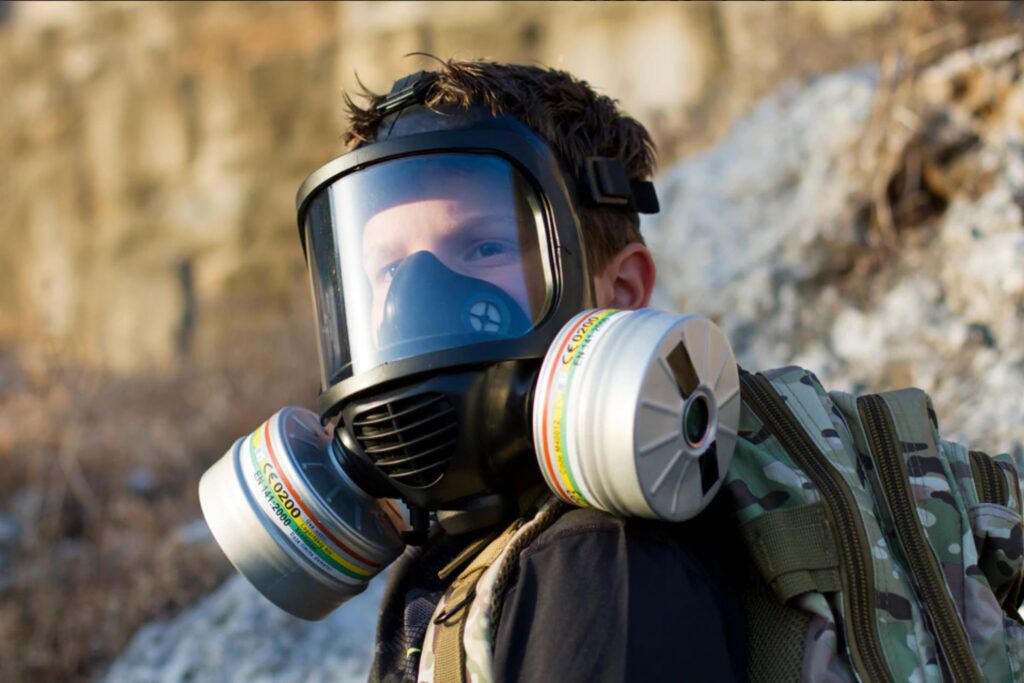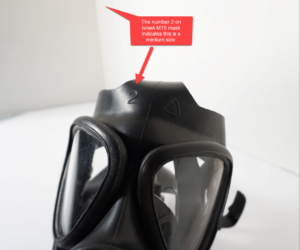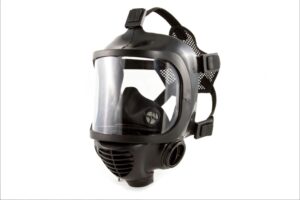
For multi decades the public’s experience with the use gas masks come primarily from either watching action movies or the news or witnessing foreign militaries or police anti-riots units during times of war or civil unrest. The last time mainstream media really focused on the use of gas masks during war type was when Israeli citizens were dawning them to protect themselves from Iraqi SCUD missile attacks during the first Gulf War.
So what does a gas mask do?
Now that war in the Ukraine has broken out, the masses are once again worried about the possibility of nuclear war and possible attack from Russia, China or North Korea. It must be noted that a gas mask WILL NOT protect you from radiation that makes contact with your skin, but a well-made gas mask that is NIOSH certified that is coupled with a NIOSH rated or `CE’ rated certified filter my provide protection from radioactive particles for a limited time.
As the name implies, the main purpose of a gas mask is to protect against harmful fumes that can come in the form of various liquid and gas-based nerve agents not to mention, tear gas and carbon monoxide. It should be noted that `full face’ respirators are also referred to as gas masks.
Here are the top 3 things you will want to consider when purchasing a gas mask:
- Size
- Seal
- Sight
Size:
The size of the mass may seem obvious here. This not like a pair of pants that my be a little too large or small around the waist. You may be uncomfortable wearing ill-fitting pants, but you will live. A mask that does not fit properly will prevent you from putting the mask on properly. The ramifications are obvious in a life-or-death situation.
Seal:
Even if your mask fits the size of your head properly, there is still the matter of a proper seal. The rubber on a mask that has been exposed to environmental extremes can degrade over time just like a tire. If you purchase a new gas mask or end up purchasing a surplus mask it is critical to ensure that there is no cracking or peeling of the rubber especially around the seal. If you find this to the be the case, you should return the mask immediately if possible or worst case dispose of the mask if you are unable to return.
It is also very important to know that in order to ensure a tight seal, being clean shaven is ideal. If you are not, you may be able to get away with a 3 o’clock shadow.
Sight:
When it comes to various makes of gas masks / full face respirators, most are very comparable. However, where you start to see some separation is in the lens size and sight lines. Some masks have small individual lenses for the eyes and others are full face lens. Many military grade gas mask have individuals lens’ and those for civilian and law enforcement tend to have full face lens. A full face lens will allow for greater situational awareness, but individual lens mask may offer greater protection from infiltration of liquid getting into the eyes.
Acronyms of Note:
NIOSH – National Institute for Occupational Safety and Health (NIOSH approves respirators in accordance with 42 Code of Federal Regulations Part 84 (42 CFR 84) and provides guidance for their use in occupational settings.) NIOSH is part of the Centers for Disease Control and Prevention (CDC) in the Department of Health and Human Services For example a true N95 mask is NIOSH certified.
NBC – (Nuclear, Biological and Chemical) – This is an older standard but still very good provided the filter is not an old expired surplus filter.
CBRN – (Chemical, Biological, Radiological and Nuclear)
Filtration:
The one take away to remember is that you will want to purchase a fresh unopened 40mm NATO Filter for your gas mask. When we say un-opened, we mean a filter where the plug has not been removed and the seal has not been broken. The plug must be removed before you attempt to screw the filter to the mask.
Ideally the filter should have the either NIOSH certification logo somewhere on the filter or CE logo (CE is a similar international standard to NIOSH.)
Special Note: Un-opened filter canisters with plug seal not broken generally will last 5 to 7 years. Check the manufacturer warranty.
How long will a filter last once properly attached to gas mask?
Dependent upon the type of gas, toxic particles, aerosols or other bacteria and viruses you may be exposed to, a mask can last on average between 8 -12 hours. If you are in an extremely toxic / highly contaminated area the time could be less than 8 hours.
Should you buy a surplus gas mask?
There are many surplus gas masks out there available for purchase, but the vast majority should not be depended upon to save your bacon in the event of an emergency. The passage of time can crack and degrade the rubber exposed to the elements used by these masks and many will not support the insertion of standard 40mm NATO filters.
If you are dead set on purchasing a surplus gas mask because you want to save a little money and want to hedge your bets on one you could trust, our recommendation is that you do your research and possibly look into a well-preserved mask. As long as the mask rubber is in good condition without cracks and can provide a good seal, this could be a great cost-effective alternative.
As stated before, you will want to make sure your order the mask in the correct size.
One example of this could be the Israeli M15. Thousands of these models were passed out to civilian adults and children during the Gulf War and many more were left over afterward and made available to the public for purchase.
Being that the Gulf war started in 1991, many of these M15 masks may be upwards of 30+ years old. However, many of these masks were produced after the Gulf war and may very well be in great condition.
Many newer gas masks and even surplus masks were designed to have a 20-year shelf-life.
We would highly recommend not using the filters that may come with surplus mask as they will be long since expired. Just purchase a newer modern 40mm filter to be on the safe side.
The photo to the right shows a surplus Israeli M-15 gas mask.
surplus Israeli M-15 gas mask.
M-15 Size Chart: No. 1 is large, 2 medium, 3 small. (This number will be found toward the top of mask just above lens/visor in rubber forehead area.
MIRA CM-6M

The MIRA CM-6M gas mask is featured pretty prominently online and on social media and for good reason, this unit covers nearly all the basis.
The mask itself is manufactured in the Czech Republic. One can purchase this mask and have piece of mind that is used by both military, law enforcement and civilians worldwide. Mira also sells a more specialized respirator called the CM-7M that is primarily for military use.
It should be noted that if you purchase the MIRA CM-6M it comes with a preinstalled hydration system (system that allows your to drink through mask) along with canteen.
PROS:
• Full face shield for excellent sightlines and situational awareness.
• Integrated speech diaphragm allowing you to communicate with others around you.
• Integrated hydration system.
• Accepts up to two NATO 40mm filters. (0ne of each side of jaw)
• Meets CBRN protection standards (Chemical, Biological, Radiological & Nuclear).
• Up to 20-year shelf life
• Comes with MIRA 5-year warranty
NOTE: This gas mask conforms to the European `Quality and Sustainability’ standards which is marked with the `CE’ symbol.
CONS:
• May be a little too pricey for the average individual or family.
• This model is not ideal if you are looking to use a rifle with optics requiring a cheek weld with and a certain degree of eye relief.
Follow this link to purchase a MIRA CM-6M Mask:
https://www.mirasafety.com/products/cm-6m-tactical-gas-mask
Mestel SGE 400 / 3BB

This is another mask that gets very good feedback. The MESTEL SGE 400/3BB is often advertised online as simply SGE 400 / 3BB. MESTEL Safety is a division of `Ocean Reef Group’ based out of Genova Italy. The OCEAN Reef group also well know for it Underwater / Diving Masks and other marine products.
Like the MIRA CM-6M, the SGE 400 / 3BB ( BB stands for butyl rubber seals) which can stand up to the most harmful and potent airborne particles and gases. This mask is certified to meet all CBRN standards when paired with a CBRN filter.
One can also go with a cheaper alternative by purchasing the SGE 400 / 3. This version uses a slightly less robust rubber than the 3BB version but still is more than durable enough for just about any civilian application.
PROS:
• Full face shield allowing for excellent visibility.
• Has three filter ports ( 1 on either side of jaw plus one in the center) which accept 40mm NATO filters.
• The SGE-400/3 models have a special resin coating applied to the polycarbonate visor which provides additional scratch & chemical resistance
CONS:
• Voice diaphragm must be ordered separately.
• As of this writing, several retail sites where the SGE 400 / 3BB can be purchased indicate that the voice diaphragm and drinking system are on back order.
• Price of the SGE 400 / 3BB may be a little too steep for the average person(s) looking for a mask of this quality.
Follow this link to purchase Mestel SGE 400 / 3BB mask:
https://parcilsafety.com/collections/mestel-collection/products/sge-400-ballistic-grade-tactical-gas-mask-full-face-respirator-mask-uncompromised-defense
Final thoughts:
We believe every household should have a gas mask for every individual within that household. How likely is it that you are ever going to have to use your gas mask? The answer to this is difficult to answer but it is fair to say base on global events, the scenarios that may warrant the use of one continue to rise. As of this writing the world is holding is breath in the hopes that Putin does not actually employee chemical weapons in the Ukraine. It goes without saying that Ukrainians’ may appreciate gas masks being available.
Here in the U.S, it is less likely that chemical weapons would be employed any time soon, but a rogue terrorist act by one or multiple parties could change things in an instant. A chemical spill, accidental release of toxic gas or even a volcanic eruption could warrant the use of Gas Mask to give one a precious hour or so to get to a safer location or situation.
Once you have acquired a suitable gas mask, the key is to make sure you familiarize yourself with how to quickly put it on, and test for air tight seal. You should get to a point where you can accomplish this in a maximum of 10 seconds but ideally in 4 -6 seconds.






